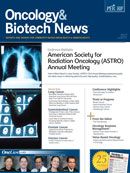Publication
Article
Oncology & Biotech News
Benefit of ADT Added to Radiation Confined to Intermediate- Risk Prostate Cancer Patients With Poor Prognosis
Author(s):
Not all intermediate-risk prostate cancer patients benefit from the addition of androgen deprivation therapy to radiation therapy.
Katherine Castle, MD
Not all intermediate-risk prostate cancer patients benefit from the addition of androgen deprivation therapy (ADT) to radiation therapy. Adding ADT to radiation improved disease-free survival (DFS) in men with intermediate-risk prostate cancer and unfavorable prognostic factors, but not in intermediate-risk men with favorable prognostics, according to a retrospective, nonrandomized study reported at the 2011 annual meeting of the American Society for Radiation Oncology.
Five-year biochemical DFS was 94% for those with an unfavorable prognosis treated with radiation plus ADT versus 74% for unfavorable prognosis patients treated with radiation alone (P = .005).
“In patients with Gleason scores of 4 3 and higher-volume disease, the addition of ADT was clearly of benefit. Randomized trials will be needed to support these data, but in the interim, these findings may help clinicians identify a favorable subset of intermediate-risk patents who can be treated with radiation alone,” stated Katherine Castle, MD, of the MD Anderson Cancer Center in Houston, Texas. Castle suggested that a personalized approach should be used to select intermediate-risk patients for radiation alone versus radiation plus short-course ADT, taking into account tumor characteristics and patient comorbidities.
Several trials have shown that the addition of short-term ADT to radiation therapy improves DFS in men with intermediate-risk prostate cancer, most recently a randomized trial by Jones et al. in the July 2011 issue of New England Journal of Medicine. But intermediate-risk patients are a heterogeneous group, and it has not been clear which subsets might benefit preferentially from the addition of ADT to radiation. This study sought to shed light on this issue.
The study analyzed outcomes of intermediate-risk prostate cancer patients treated with intensity-modulated radiation therapy or 3D conformal radiation at the MD Anderson Cancer Center between 1993 and 2008. Radiation alone (doses of 75.6-78 Gy) was given to 327 intermediaterisk patients, and radiation plus up to 6 months of ADT was given to 218 intermediate-risk patients.
Intermediate-risk patients were categorized as favorable, unfavorable, or marginal prognostic subgroups according to Gleason score, T stage, and pretreatment prostate-specific antigen (PSA) level. Favorable patients (n = 188) had Gleason score of 6 and stages T1b-T2b, or stages T1b-c and Gleason score of 3 4. Marginal patients (n = 71) were those with stages T2a-b and Gleason score of 3 4. Unfavorable patients (n = 68) had stage T2c or Gleason score of 4 3. Hazard ratios for recurrence were 1 for the favorable group, 2.1 for the marginal group, and 4.6 for the unfavorable group.
Unlike the unfavorable prognosis patients who showed a benefit from additional therapy, patients with a favorable prognosis got no benefit from radiation plus ADT versus those who received radiation alone; DFS was 94% and 95%, respectively. Marginal prognosis patients had 5-year DFS rates of 91% for radiation alone and 100% for radiation plus ADT (P = .07).


































%20(2)%201-Recovered-Recovered-Recovered-Recovered-Recovered-Recovered-Recovered-Recovered-Recovered-Recovered-Recovered-Recovered-Recovered-Recovered-Recovered-Recovered-Recovered.jpg?fit=crop&auto=format)
%20(2)%201-Recovered-Recovered-Recovered-Recovered-Recovered-Recovered-Recovered-Recovered-Recovered-Recovered-Recovered-Recovered-Recovered-Recovered-Recovered-Recovered-Recovered.jpg?fit=crop&auto=format)